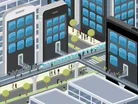South Africa: smart cities beginning to materialise

The utopian vision of the Smart City often involves carefully orchestrated traffic and public transport systems, connected with Internet Protocol (IP) security cameras, solar power generators, well-functioning water and sanitation services, city-wide access and payment solutions using smartcards and biometrics.
It evokes images of the digital cityscapes seen in the popular video game, The Sims. While in reality, South Africa may have to wait some time to see these kinds of integrated city-wide systems, the good news is that the first steps on the journey to smart cities are starting to materialise.
RELATED: Eko Atlantic launches smartphone app to woo potential buyers
In the country’s economic hub of Johannesburg, citizen reporting initiatives allow individuals to report issues with road conditions, community safety, and waste management.
In the case of the Johannesburg Road Agency’s (JRA) ‘Find and Fix’ app, people can report potholes and other road maintenance issues, supported with images taken on the phone’s camera, and automatic geolocation data recorded from the smartphone’s Global Positioning System (GPS). These reports are plugged into the JRA’s backend systems – which sees crews of maintenance staff being dispatched to solve the reported problems.
Similar pilots are now in progress with city authorities the areas of waste management and community security forums. These services use the same reporting platform, with different user interfaces to the customer at the front end, and custom integration to the relevant authority on the back end.
In the private sector, the reporting platform has even been applied to the world of facilities management, to ease the process of reporting and fixing building maintenance issues. It can be adapted and scaled in many different directions.
We believe these examples are something of a portent for the future. If step one is all about ‘human-generated’ data (reports on potholes, for example), then step two will involve integrating machine-generated data (such as connected cameras that estimate the wait time at public bus terminals, or in queues at your local Home Affairs office).
In this step, sophisticated algorithms interpret these various data sources – from sensors, cameras, or any other kind of connected device – and produce useful insights to citizens. So, an IP camera records the density of people waiting at a bus terminal, and translates it into a ‘likely waiting time’ indication for people heading to the terminal.
RELATED: The Top 10 most tourism-ready African economies of 2015
With rich flows of human-generated and machine-generated data, city authorities and administrators get far more accurate view of the services under their control, and the issues facing citizens. This forms the basis for improved decision-making – from budgeting decisions, to public transport planning, traffic management strategies, policing issues, and more.
In our vision for the future of South African smart cities, reaching ‘step three’ requires other elements to fall into place. In this step, ubiquitous smartphone penetration and the proliferation of free urban Wi-Fi networks are required. Fortunately, these bigger infrastructure and environmental requirements will likely become a reality within the next few years.
Step three is essentially defined as:
• The mass-scale adoption of citizen reporting and engagement tools.
• A wide array of smart city services across many areas of service delivery and many different departments or city authorities.
• Big Data insights that are processed by sophisticated systems, using machine learning.
In this way, the flood of incoming data is handled in real-time by processing systems. These systems can dynamically alter the timing of traffic lights, the schedules of maintenance and sanitation crews, the dispatching of emergency teams, the routings of trains and buses, or indeed just about any other form of Smart City service.
By following this logical sequence and taking things step-by-step, we’ll learn about the optimal ways to configure our systems and to learn from the data. Ultimately, if we get this right, there is no reason why we cannot progress towards our utopian vision of the Smart City.
By Lionel Moyal, Head of Intervate, a T-Systems company
February’s Issue of African Business Review is live.
Follow @MrNLon and @AfricaBizReview on Twitter.
Like our Facebook Page.



